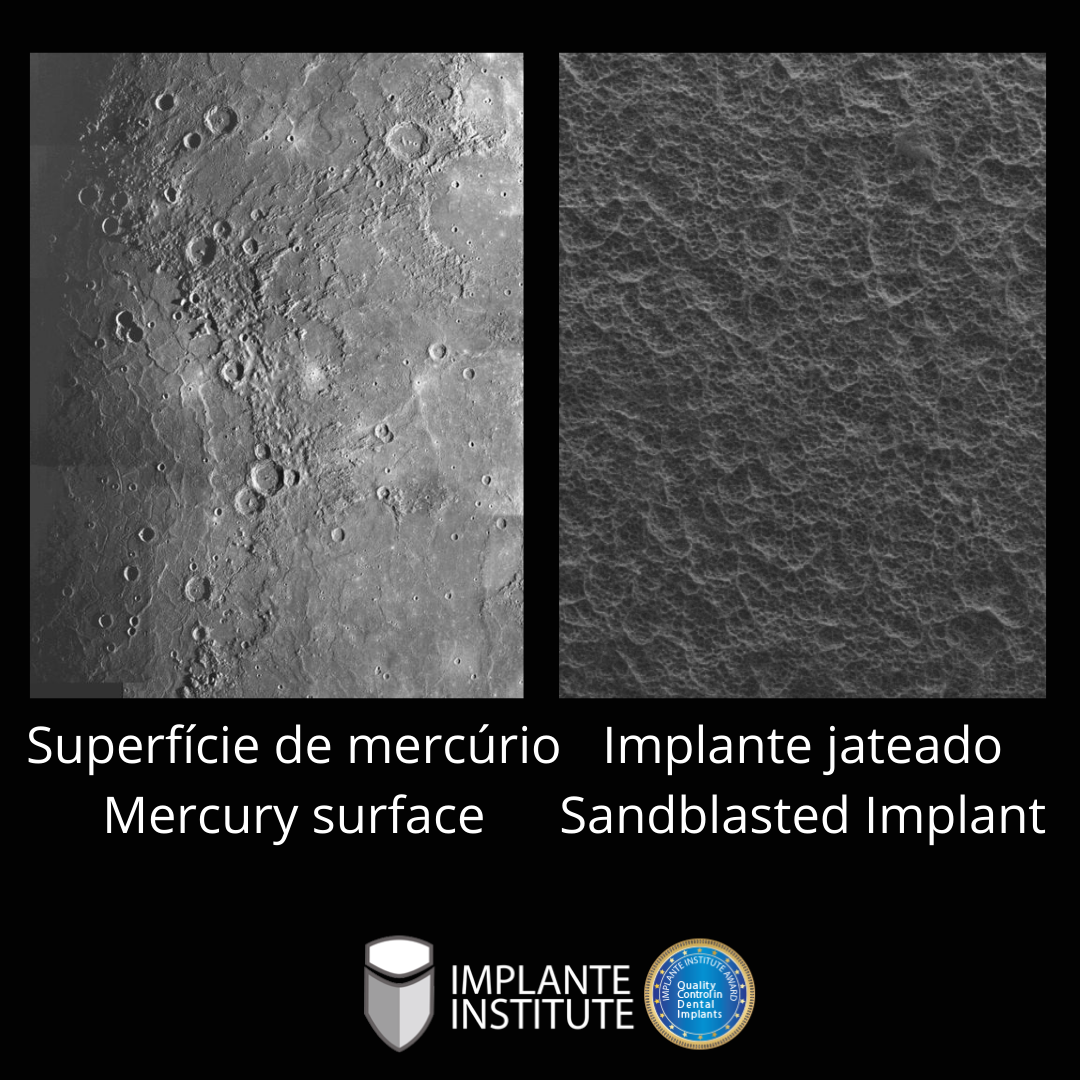Superfície de Mercúrio e Implante Jateado
Mercúrio tem uma aparência similar à da Lua com crateras de impacto e planícies lisas, não possuindo satélites naturais nem uma atmosfera substancial. Entretanto, diferentemente da Lua, possui uma grande quantidade de ferro no núcleo que gera um campo magnético, cuja intensidade é cerca de 1% da intensidade do campo magnético da Terra.[5] É um planeta excepcionalmente denso devido ao tamanho relativo de seu núcleo. A temperatura em sua superfície varia de 90 a 700 K (−183 °C a 427 °C).[6] O ponto subsolar é a região mais quente e o fundo das crateras perto dos polos as regiões mais frias.
As primeiras observações registradas de Mercúrio datam pelo menos do primeiro milênio antes de Cristo. Antes do século IV a.C., astrônomos gregos acreditavam que se tratasse de dois objetos distintos: um visível no nascer do sol, ao qual chamavam Apolo, e outro visível ao pôr do Sol, chamado de Hermes.[7] O nome em português para o planeta provém da Roma Antiga, onde o astro recebeu o nome do deus romano Mercúrio, que tinha na mitologia grega o nome de Hermes (Ἑρμῆς). O símbolo astronômico de Mercúrio é uma versão estilizada do caduceu de Hermes.[8]
Mercúrio foi intensamente bombardeado por cometas e asteroides durante e logo depois da sua formação há 4,6 bilhões de anos, como também durante um possível episódio subsequente denominado "Intenso bombardeio tardio", que se encerrou há 3,8 bilhões de anos.[10] Durante esse período de intensa formação de crateras, o planeta recebeu impactos sobre toda a sua superfície,[29] o que foi facilitado pela ausência de qualquer atmosfera que diminuísse os impactos.[30] Durante esse período o planeta teve atividade vulcânica e bacias como a Caloris foram preenchidas por magma do interior planetário, que produziram planícies suaves similares aos mares lunares.[31][32]
Dados do sobrevoo da MESSENGER de outubro de 2008 forneceram aos pesquisadores uma melhor avaliação da natureza confusa da superfície mercuriana. Sua superfície é mais heterogênea que a marciana ou lunar, as quais contêm falhas significativas de geologia similar, como os mares e platôs.[33]
https://pt.wikipedia.org/wiki/Merc%C3%BArio_(planeta)#Geologia_da_superf%C3%ADcie

Mercury's surface is similar in appearance to that of the Moon, showing extensive mare-like plains and heavy cratering, indicating that it has been geologically inactive for billions of years. It is more heterogeneous than either Mars's or the Moon's, both of which contain significant stretches of similar geology, such as maria and plateaus.[49] Albedo features are areas of markedly different reflectivity, which include impact craters, the resulting ejecta, and ray systems. Larger albedo features correspond to higher reflectivity plains.[50] Mercury has dorsa (also called "wrinkle-ridges"), Moon-like highlands, montes (mountains), planitiae (plains), rupes (escarpments), and valles (valleys).[51][52]
Mercury was heavily bombarded by comets and asteroids during and shortly following its formation 4.6 billion years ago, as well as during a possibly separate subsequent episode called the Late Heavy Bombardment that ended 3.8 billion years ago.[55] Mercury received impacts over its entire surface during this period of intense crater formation,[52] facilitated by the lack of any atmosphere to slow impactors down.[56] During this time Mercury was volcanically active; basins were filled by magma, producing smooth plains similar to the maria found on the Moon.[57][58] An unusual crater with radiating troughs has been discovered that scientists called "the spider".[59] It was later named Apollodorus.[60]
Craters on Mercury range in diameter from small bowl-shaped cavities to multi-ringed impact basins hundreds of kilometers across. They appear in all states of degradation, from relatively fresh rayed craters to highly degraded crater remnants. Mercurian craters differ subtly from lunar craters in that the area blanketed by their ejecta is much smaller, a consequence of Mercury's stronger surface gravity.[61] According to International Astronomical Union (IAU) rules, each new crater must be named after an artist who was famous for more than fifty years, and dead for more than three years, before the date the crater is named.[62]
Overhead view of Caloris Basin
Perspective view of Caloris Basin – high (red); low (blue)
The largest known crater is Caloris Planitia, or Caloris Basin, with a diameter of 1,550 km.[63] The impact that created the Caloris Basin was so powerful that it caused lava eruptions and left a concentric mountainous ring ~2 km tall surrounding the impact crater. The floor of the Caloris Basin is filled by a geologically distinct flat plain, broken up by ridges and fractures in a roughly polygonal pattern. It is not clear whether they are volcanic lava flows induced by the impact or a large sheet of impact melt.[61]
At the antipode of the Caloris Basin is a large region of unusual, hilly terrain known as the "Weird Terrain". One hypothesis for its origin is that shock waves generated during the Caloris impact traveled around Mercury, converging at the basin's antipode (180 degrees away). The resulting high stresses fractured the surface.[64] Alternatively, it has been suggested that this terrain formed as a result of the convergence of ejecta at this basin's antipode.[65]
Tolstoj basin is along the bottom of this image of Mercury's limb
Overall, 46 impact basins have been identified.[66] A notable basin is the 400 km wide, multi-ring Tolstoj Basin that has an ejecta blanket extending up to 500 km from its rim and a floor that has been filled by smooth plains materials. Beethoven Basin has a similar-sized ejecta blanket and a 625 km diameter rim.[61] Like the Moon, the surface of Mercury has likely incurred the effects of space weathering processes, including solar wind and micrometeorite impacts.[67]
https://en.wikipedia.org/wiki/Mercury_(planet)



